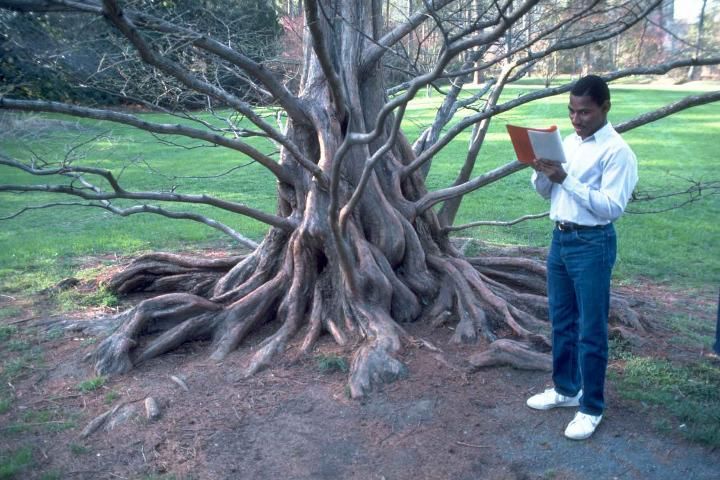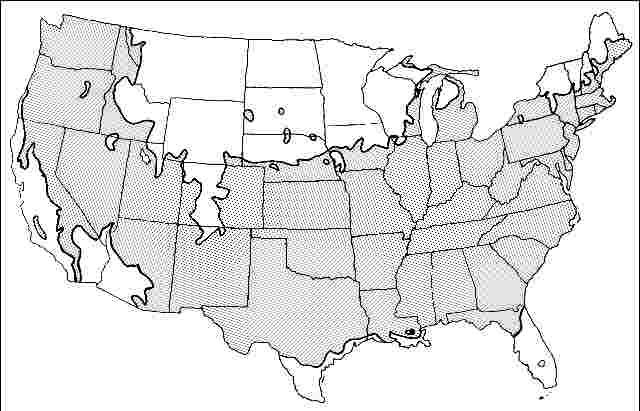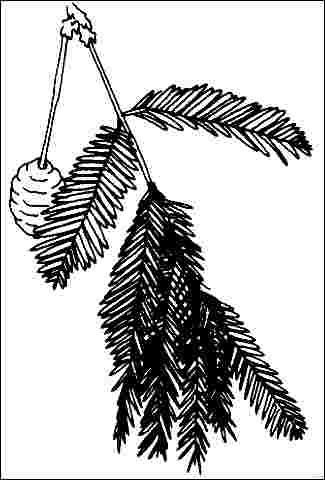Introduction
Dawn redwood grows in a perfect pyramid 70 to 90 feet tall and was known from fossils before living plants were discovered in China. It is similar in appearance to bald cypress. Although it looks like an evergreen, the needles are deciduous. The orange-red to brown trunk base is the most outstanding part of the tree. It tapers and thickens quickly with 8 to 12 large buttress-like root flares extending several feet up the tree in a manner unlike any other tree except some tropical trees. As with any other tree, butt flare (increased caliper at the base of the trunk) can be reduced somewhat by removing the lower branches at an early age. The small, upright-spreading branches are well-attached to the typically straight trunk and make for excellent climbing. The tree requires little if any pruning to maintain the pyramidal form. Lightning protection is recommended for older trees since they usually grow taller than most others.

Credit: Ed Gilman, UF/IFAS
General Information
Scientific name: Metasequoia glyptostroboides
Pronunciation: met-uh-see-KWOY-uh glip-toe-stroe-BOY-deez
Common name(s): Dawn redwood
Family: Taxodiaceae
USDA hardiness zones: 5A through 8B (Fig. 2)
Origin: not native to North America
Invasive potential: little invasive potential
Uses: screen; specimen; street without sidewalk; parking lot island 100-200 sq ft; parking lot island > 200 sq ft; sidewalk cutout (tree pit); tree lawn 4-6 feet wide; tree lawn > 6 ft wide; highway median
Availability: somewhat available, may have to go out of the region to find the tree

Description
Height: 70 to 90 feet
Spread: 15 to 25 feet
Crown uniformity: symmetrical
Crown shape: pyramidal
Crown density: open
Growth rate: fast
Texture: fine
Foliage
Leaf arrangement: opposite/subopposite (Fig. 3)
Leaf type: simple
Leaf margin: entire
Leaf shape: linear
Leaf venation: none, or difficult to see
Leaf type and persistence: deciduous
Leaf blade length: less than 2 inches
Leaf color: green
Fall color: yellow, orange
Fall characteristic: showy

Flower
Flower color: unknown
Flower characteristics: not showy
Fruit
Fruit shape: round, elongated
Fruit length: .5 to 1 inch
Fruit covering: dry or hard
Fruit color: brown
Fruit characteristics: does not attract wildlife; not showy; fruit/leaves not a litter problem
Trunk and Branches
Trunk/bark/branches: branches droop; very showy; typically one trunk; thorns
Pruning requirement: little required
Breakage: resistant
Current year twig color: green, brown
Current year twig thickness: thin
Wood specific gravity: unknown
Culture
Light requirement: full sun
Soil tolerances: clay; sand; loam; acidic; extended flooding; well-drained
Drought tolerance: moderate
Aerosol salt tolerance: low
Other
Roots: not a problem
Winter interest: yes
Outstanding tree: yes
Ozone sensitivity: tolerant
Verticillium wilt susceptibility: resistant
Pest resistance: resistant to pests/diseases
Use and Management
The tree has been used primarily as a specimen, but there are reports of it being very tolerant of air pollution and it has done well as a street tree with lower branches removed. Lower branches should be left on the tree for most other uses to enjoy the graceful form and delightful foliage. Do not plant in soil with a high pH.
The tree grows rapidly but late season growth may be injured by early frosts. The preferred soil is moist and moderately fertile, but Metasequoia does not appear to be impacted by drought, having survived in urban landscapes during recent summer droughts. It will also tolerate wet soil. It appears to be adapted to clay soil and grows best when located on continually moist sites with slightly acidic soil.
Propagation is from seeds or cuttings taken in late summer.
The cultivar 'National' grows to 85 feet tall.
Pests and Diseases
Relatively free of pests, except for a canker which has been reported recently.
